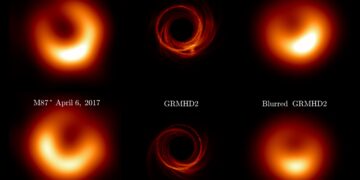The universe’s mysteries continue to captivate scientists and enthusiasts alike, and one of the most enigmatic phenomena is the supermassive black hole, M87*. Located at the heart of the Messier 87 galaxy, this cosmic giant has been at the center of cutting-edge research. Thanks to the Event Horizon Telescope (EHT) collaboration, new findings from 2017 and 2018 observations are shedding light on the dynamic and turbulent nature of M87*’s accretion flow.
The 2017–2018 Observations: A Closer Look at M87*
In 2019, the EHT stunned the world with the first-ever image of a black hole, M87*, revealing a luminous ring surrounding a dark shadow. Recent analysis of 2017 and 2018 data further refines our understanding of this supermassive black hole. The observations confirmed the ring’s diameter to be about 43 microarcseconds, aligning perfectly with theoretical predictions for a black hole weighing 6.5 billion solar masses.
What makes this new analysis extraordinary is the detection of subtle changes in the accretion disk’s turbulence. The brightest region of the ring shifted approximately 30 degrees counterclockwise between the two observation years. Such variations offer a rare glimpse into the dynamic interplay of plasma and gravitational forces near the event horizon.
How the EHT Captures These Phenomena
The EHT employs a network of radio observatories around the globe, working together as a virtual Earth-sized telescope. This revolutionary method, known as very long baseline interferometry (VLBI), allows the EHT to achieve unparalleled resolution, making it possible to observe details near a black hole’s event horizon.
In the 2018 campaign, the EHT expanded its array with observatories such as ALMA in Chile and the Greenland Telescope. This upgrade provided a synthetic dataset three times larger than in 2017, enabling deeper analysis of the accretion flow and plasma structures around M87*.
Dynamic simulations bring clarity Advanced simulations played a critical role in interpreting the observations. These models revealed that the gas spiraling into M87*’s accretion disk flows counter to the black hole’s spin.
The Science Behind the Turbulent Accretion Flow
An accretion disk is a swirling structure of gas and dust that forms around massive objects like black holes. As material falls inward, it heats up and emits electromagnetic radiation, which can be observed by telescopes like the EHT. Studying accretion disks is crucial for understanding how black holes grow and how they influence their host galaxies.
Unveiling plasma dynamics near the event horizon The observations and simulations showed that the plasma near M87* is highly turbulent and dynamic. The shifting brightness in the ring indicates complex variability mechanisms, potentially driven by magnetic fields and the interplay between gas and gravitational forces.
Complementary Observations from GMVA
The Global Millimeter VLBI Array (GMVA) contributed to the study of M87* by observing it at a wavelength of 3 mm, compared to the EHT’s 1.3 mm. These complementary observations provided a more comprehensive view of the black hole’s environment, revealing additional details about plasma structures and their evolution over time.
The collaboration between GMVA and EHT exemplifies the importance of integrating data from multiple sources to enhance our understanding of complex astrophysical phenomena.
Implications for Black Hole Physics
The new findings have significant implications for black hole physics. By identifying gas flow patterns counter to the black hole’s spin, researchers can refine models of angular momentum transfer and magnetic field interactions.
A step toward understanding extreme environments The study highlights the importance of iterative modeling and observation. By combining multi-year data with advanced simulations, scientists can explore the extreme conditions near black holes, paving the way for breakthroughs in our understanding of gravity, relativity, and high-energy astrophysics.
The Role of Collaboration and Technology
The EHT is a testament to the power of international collaboration. Scientists from institutions worldwide, including the Max Planck Institute for Radio Astronomy, the University of Würzburg, and others, contributed to this groundbreaking research. Such partnerships are essential for tackling the complex challenges of black hole studies.
Technological innovation as the backbone of discovery The success of the EHT depends on cutting-edge technology, from advanced radio telescopes to powerful computational models. As new instruments like the next-generation EHT come online, researchers will gain even greater capabilities to probe black hole environments with unprecedented detail.
Why M87 Matters*
M87* is not just any black hole—it’s a supermassive giant with immense influence over its host galaxy. By studying M87*, scientists can gain insights into the role of black holes in galaxy formation and evolution.
Inspiring the next generation of discoveries The EHT’s work on M87* has captured the imagination of people worldwide, sparking curiosity and inspiring future generations of scientists. As researchers continue to analyze data from subsequent years (2021 and 2022), the story of M87* is far from over. Each new discovery brings us closer to unraveling the mysteries of the cosmos.
Conclusion
The latest observations of M87* by the Event Horizon Telescope mark a significant milestone in black hole research. By combining multi-epoch data with advanced simulations, scientists have unveiled new details about the turbulent accretion flow around this supermassive black hole. These findings not only refine our understanding of black hole physics but also demonstrate the power of global collaboration and technological innovation.
Reference:
The persistent shadow of the supermassive black hole of M87, Astronomy & Astrophysics (2025)



















